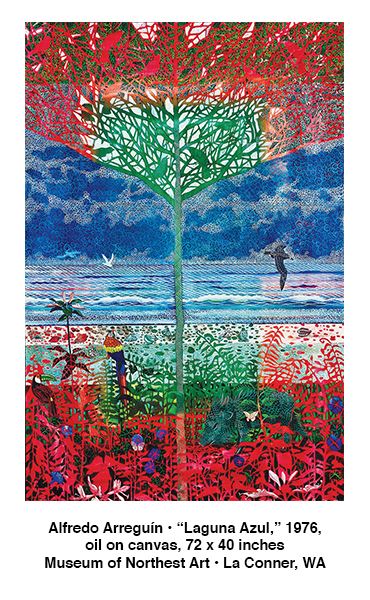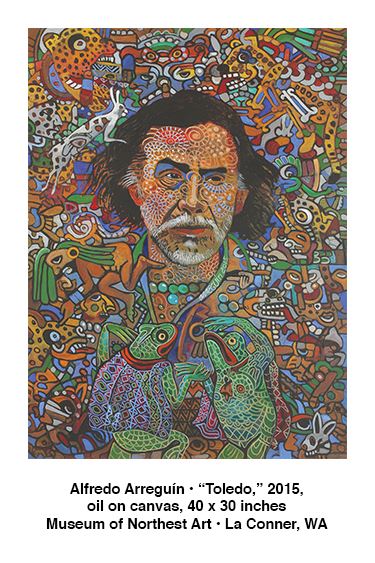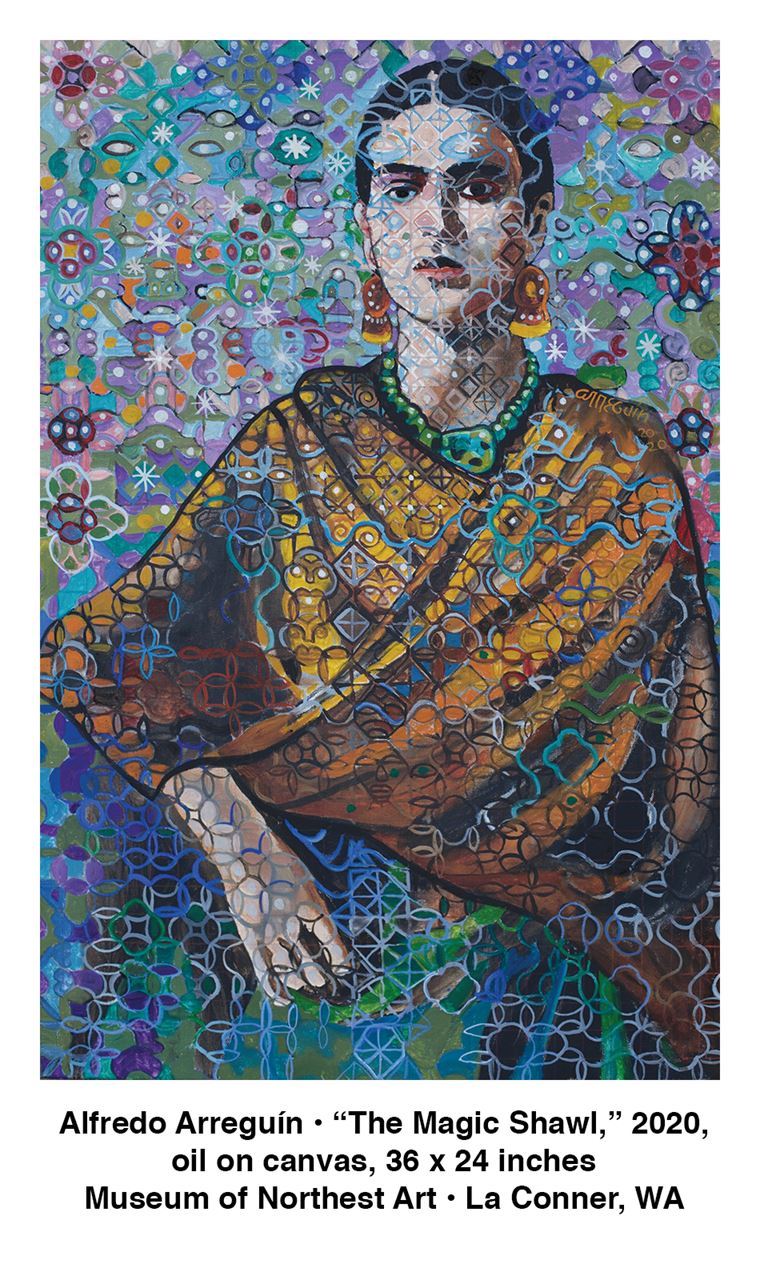 “Art isn’t a way to be famous and rich, but it is a way to connect on a spiritual level with your paintings, people, and good friends.” This quote by Alfredo Arreguín from the DreamPath Podcast, Episode 8 perhaps best describes the acclaimed artist’s goal for his work. Arreguín’s unique combination of complex, geometric patterns with portraiture and landscape elements blend to create for the viewer either a spiritual moment or opportunity for introspection. The exhibit, “Arreguín: Painter from the New World,” brings together two key elements of the artist’s style: abstraction and formative cultural elements. Both characteristics of the artist’s aesthetic exemplify a style that is instantly recognizable in the Pacific Northwest and beyond.
“Art isn’t a way to be famous and rich, but it is a way to connect on a spiritual level with your paintings, people, and good friends.” This quote by Alfredo Arreguín from the DreamPath Podcast, Episode 8 perhaps best describes the acclaimed artist’s goal for his work. Arreguín’s unique combination of complex, geometric patterns with portraiture and landscape elements blend to create for the viewer either a spiritual moment or opportunity for introspection. The exhibit, “Arreguín: Painter from the New World,” brings together two key elements of the artist’s style: abstraction and formative cultural elements. Both characteristics of the artist’s aesthetic exemplify a style that is instantly recognizable in the Pacific Northwest and beyond.
Alfredo Arreguín’s artworks are included in many key art collections around the world, including significant paintings at the Smithsonian Museum of American Art, the U.S. Department of State’s Art in Embassies program, and the Seattle Art Museum. This writer is often delighted by recognizing one of his familiar scenes from across the gallery in numerous art museums around the country. Western Washington has enjoyed several major solo exhibitions of the artist’s work, including most recently an exhibition at the Bainbridge Island Museum of Art. The exhibit at the Museum of Northwest Art adds an additional art historical element for the viewer to consider when experiencing Arreguín’s work: European Modernism. This formal analysis references several of the artist’s instructors from his time at the University of Washington, many of whom have work on display in the second-floor galleries. 
One such instructor was Francis Celentano, a professor of painting at the University of Washington and key figure in the Op Art movement in the United States in the 1960s. A quote by Arreguín explains the relationship between the two artists: “I was getting good at figurative art so in his class he had a set-up with white geometric shapes. He asked me to join his class. All that light and subtlety and shapes—it was very inspiring. These were things I could do in my own compositions.” The exhibition includes several new and older paintings that highlight the artist’s stated interest in both geometric shapes and the influence of light on those forms. “Emerald Island” from 1970 is at the entrance of the exhibition, a location of prominence since it was the first of the artist’s pattern paintings. A grid defines the composition and squares are filled with gradient colors that evoke shadows amongst the confident lines. Inside the boxes are seemingly unrecognizable characters that retain the artist’s hand in their calligraphic style. As the root of Arreguín’s signature style, “Emerald Island” illustrates the juxtapositions in his work: geometry combined with organic and naturalistic elements.
The exhibition is loosely organized based on several themes. The first paintings lay the groundwork for a consideration of the artist’s interest in geometric abstraction and other modernist artistic movements in the 20th century. The artworks that follow are excellent examples of the other main characters in the artist’s oeuvre: the figure and nature. Arreguín includes many beloved Northwest animals, such as salmon and orca whales, in his recent work. The artist has long featured the jungle in his work, often drawing from his experience as a child growing up in Morelia. The jungle provides the artist with a lush, natural backdrop, which he then often organizes with intricate pattern designs. Some of his work appears to comment on the delicate balance of these scenes. This is best illustrated in “Kodiak II,” which features a solitary moose standing over the shrinking glaciers in Alaska. 
Arreguín’s paintings of almost otherworldly landscapes are as recognizable as his portraits. Some include prominent historical figures like Frida Kahlo, while others feature other artists and writers that the artist knows personally. Many of his subjects endured great adversity. Whether the challenges they faced were physical, such as Kahlo, or in the fight for rights, Arreguín pays homage to their courage and determination. The gallery guide created for the exhibition is an excellent resource for visitors to learn more about the artist’s interest in portraiture, in addition to the range of cultural influences that inform and inspire the artist’s work. The guide provides a lens for understanding his imagination, memories, and vision.
As a compliment to Arreguín’s exhibition, the museum features “In Pursuit of Abstraction: Instructors at the University of Washington School of Art in the 1960s”. Several artists mentioned in Arreguín’s exhibition have artworks on display in the second-floor galleries and there is another informative gallery guide available that describes the various art historical “isms” in the show.
Chloé Dye Sherpe
Chloé Dye Sherpe is a curator and art professional based in Washington State.
“Arreguín: Painter from the New World,” guest curated by Matthew Kangas, is on view through October 9, Monday through Sunday, 10 A.M. to 5 P.M. at Museum of Northwest Art, located at 121 South First Street in La Conner, Washington. For more information, visit www.monamuseum.org.